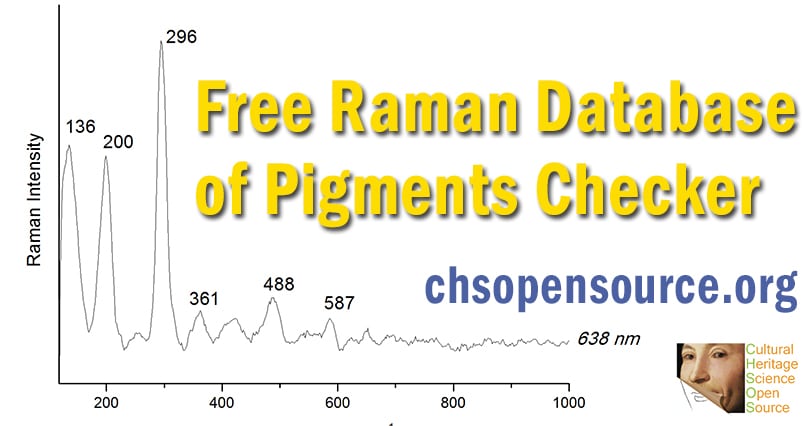
We just published the new Free Raman Spectroscopy Database of Pigments Checker.
Read more: “Pigments Checker version 3.0, a handy set for conservation scientists: A free online Raman spectra database” .

Click here and browse Pigments Table. Check out the Raman spectrum of each pigment and download the editable spectra (txt format).
Pigments Checker is a collection of swatches of historical pigments that offers art professionals, conservation scientists, conservators and fine art photographers, a tool to evaluate and test their imaging and spectroscopic methodologies for pigment identification. “Pigments Checker Free Spectra Database” is an ongoing project to thoroughly characterize each pigment in the collection with a series of spectroscopic and imaging techniques and to make the data open access. Future analysis with FT-IR and XRD will be pursued in order to achieve a broader characterization of the pigments.

In the late 1990’ when Raman spectroscopy started to show its potential in art conservation, a major issue was the lack of databases of reference Raman spectra which are necessary to compare spectra of unknown materials and properly interpret spectral features. Spectral libraries where published on scientific journals since then and even recently new libraries on more specific pigments and dyes collections have been presented.
Only in the early 2000’ the first Raman databases of pigments were available online. University College London was among the first to upload on their website a collection of spectra acquired with dispersive Raman at 514 nm and 632 nm; IRUG (Infrared and Raman users group) is certainly the most extensive database with a supporting community submitting new spectra acquired with different equipment from the numerous partner institutions; E-Visart is a database developed by University of the Basque Country (Spain) and it covers pigments and archeological materials with FT-Raman and dispersive Raman with excitation at 780 nm. The Romanian Database of Raman Spectroscopy uses a 532 nm laser. Some Institutions also published large databases of minerals including pigments, such as University of Arizona and University of Parma.
We just published a new online Raman database of the pigments contained in Pigments Checker, a collection of swatches of standard historical and modern pigments. The pigments are mulled into the binder (acrylic) which is added as needed for each pigment and applied with brush. Among all the pigments and their varieties ever used in art these selected pigments represent the most used ones from antiquity to early 1950’s.
The goals of the “Pigments Checker Free Spectra Database” are:
- Define a standard set of historical and modern pigments. All of the Raman databases introduced so far have been collected on samples of different origins. Some pigments belong to collections owned by some institutions, others are manufactured by companies specialized in historical pigments, while others are minerals collected over different geographical locations. Such a variety implies that the pigments’ chemical composition could be different due to a number of factors. For example, mineral pigments usually have specific impurities related to different origins and artificial pigments can have been produced with slightly different formulations, as often happened across their history. Pigments Checker provides a standard set of historical pigments that can be used by researchers and art professionals across different institutions and geographical locations to evaluate and practice their diagnostic methods.
- Provide a complete characterization of Pigments Checker’s samples. The set of Reflectance, Raman and XRF spectra will provide deep understanding of the chemical composition of the set of standard pigments and will allow to confirm their composition.
- Test different wavelength excitations. Pigments have been tested with 3 lasers and the database shows how each pigment responds to the 3 excitations. This information is useful to inform an actual analysis of the pigments on works of art.







